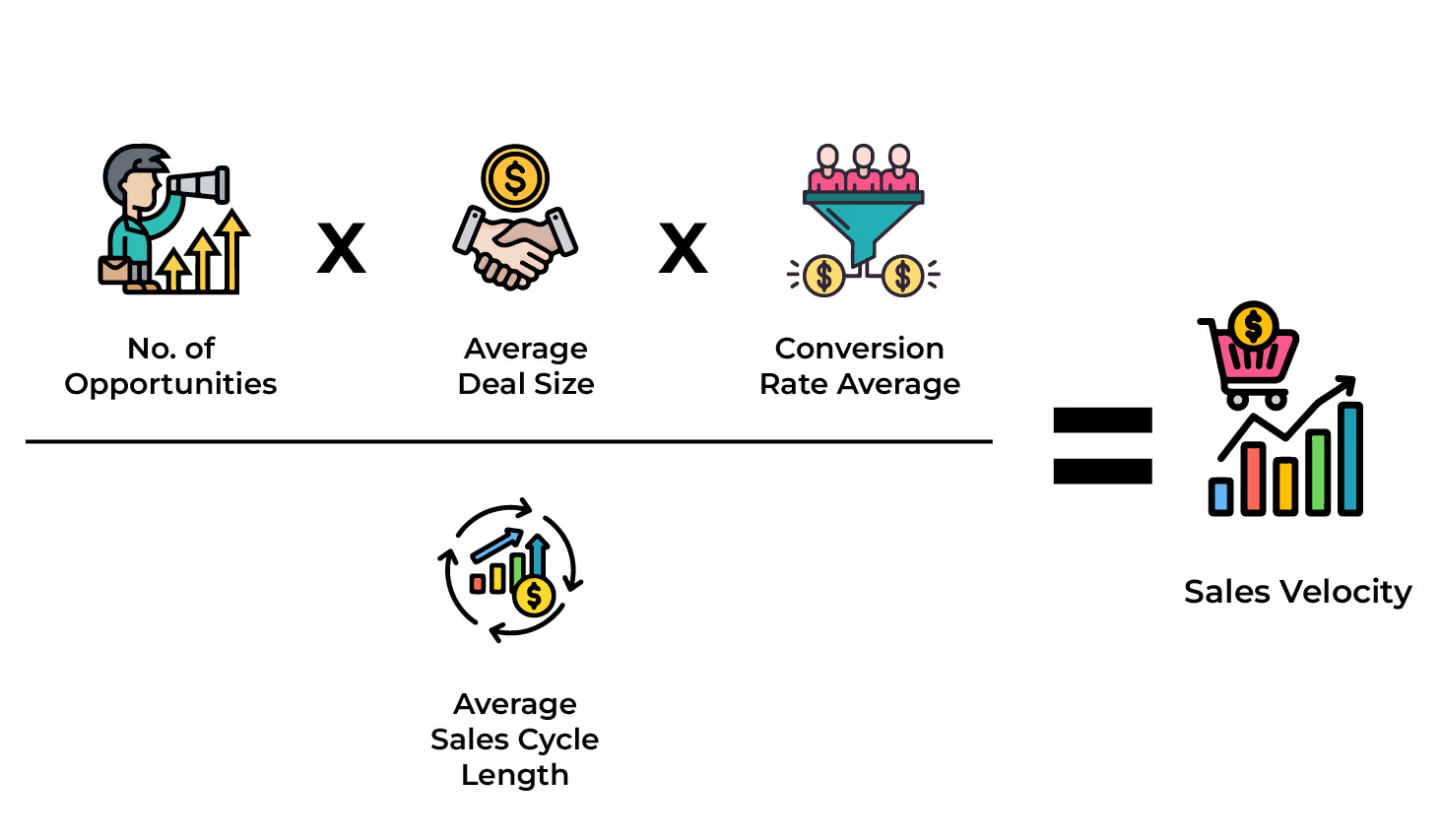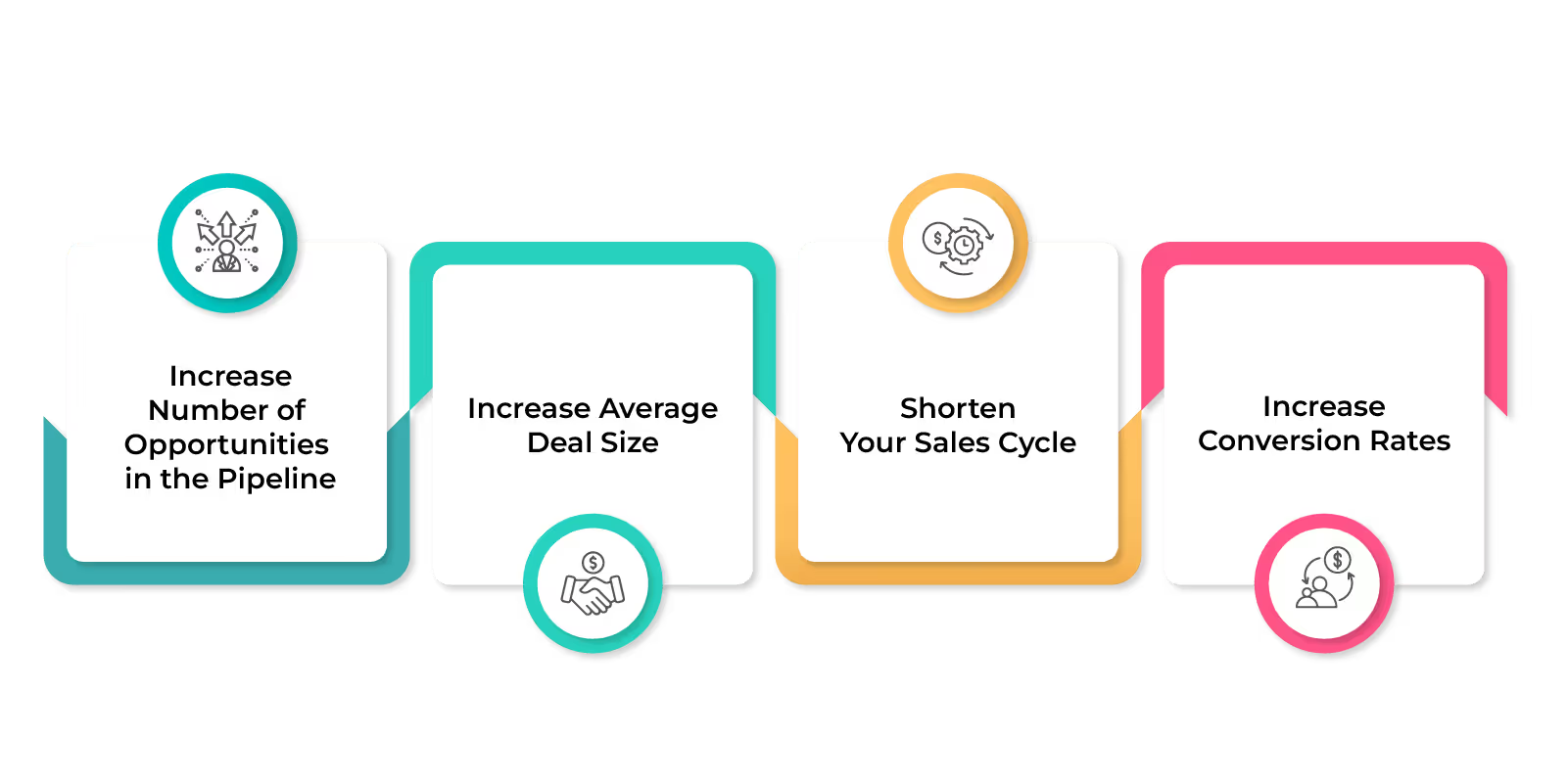
Blog
What is Sales Velocity and How to Calculate it?
December 15, 2023


Key Insights
Have you ever wondered why some businesses seem to effortlessly hit their sales targets while others struggle to make ends meet?
The secret might not be in the number of sales alone but in understanding how quickly these sales occur.
This is where the concept of sales velocity comes into play—a crucial metric that can dramatically shift how you approach your sales strategy.
Sales velocity is about measuring the speed at which your business earns money from its sales efforts. It isn't just about closing deals; it's about closing them efficiently and consistently over time.
In this blog, we'll dive into what sales velocity is, why it's important to track, and how it can help you refine your sales processes to boost your business's bottom line.
So, if you're looking to not just survive but thrive in today’s competitive market, keep reading to discover how mastering this metric can be a game-changer for your sales team.
What Is Sales Velocity?
Sales velocity is a measure used to calculate the speed at which a business generates revenue from its sales pipeline.
It quantifies how quickly a company can convert its leads into paying customers, offering a clear snapshot of its sales effectiveness.
The formula to calculate sales velocity involves four key components:
- Number of Opportunities: The total number of potential sales deals you have in your pipeline.
- Average Deal Value: The average dollar amount of each sale.
- Win Rate: The percentage of opportunities that convert into actual sales.
- Length of Sales Cycle: The average time it takes to close a deal.
By multiplying the number of opportunities by the average deal value and win rate, and then dividing by the length of the sales cycle, you get the sales velocity.
This metric is typically expressed as revenue per day, which helps businesses understand how much income their sales efforts are generating daily.
Sales Velocity Definition
Sales velocity is a crucial metric for any sales team. It’s a measure of how quickly your business is making money from its sales efforts.
Essentially, it tells you the rate at which money is entering your business through sales over a given period.
Understanding this helps you gauge the health and efficiency of your sales process.
Pipeline Velocity vs. Sales Velocity
Imagine you're in a racecar.
Pipeline velocity measures how quickly you're passing each checkpoint — it's about how fast you're moving opportunities through your sales pipeline.
On the other hand, sales velocity is about how quickly you're earning revenue from those opportunities.
It's not just speed; it’s about how efficiently your entire sales process converts leads into paying customers.

Sales Velocity vs. Inventory Velocity
While sales velocity focuses on the rate at which sales are closed and revenue is generated, inventory velocity is a whole different ballgame.
It measures how fast products are moving off the shelves and being replaced.
Think of it like this: sales velocity shows how quickly you're making money, whereas inventory velocity shows how efficiently you're managing your stock.
Sales Velocity Formula and Calculation
Understanding the sales velocity formula is critical for optimizing your sales strategy. Here’s how it breaks down:
Sales Velocity Formula:
The formula for sales velocity is straightforward yet powerful:

Sales Velocity=Number of Opportunities×Average Deal Size×Conversion RateAverage/ Average Sales Cycle Length
This equation gives you the revenue per day that your sales team generates.
How to Calculate Sales Velocity
To calculate your sales velocity accurately, consider these key components:
- Number of Qualified Opportunities: These are not just any leads; they're the ones likely to close based on your criteria.
- Average Deal Size: This is the average revenue expected from each closed deal.
- Conversion Rate: The percentage of opportunities that turn into actual sales.
- Average Sales Cycle Length: How long, on average, it takes to close a deal from start to finish.
Sales Velocity Calculator
For those who prefer a more hands-off approach, a sales velocity calculator can be a game-changer.
Simply input your data, and get a clear picture of your sales performance metrics.
How to Increase Sales Velocity
To supercharge your sales velocity, consider these strategic actions:

- Increase Number of Opportunities in the Pipeline: Boost your marketing efforts or refine your prospecting techniques to fill your pipeline with high-quality leads.
- Increase Average Deal Size: Up-sell and cross-sell where appropriate, and focus on higher-value deals to push the average deal size up.
- Shorten Your Sales Cycle: Streamline your sales process, automate where possible, and remove any bottlenecks to make your cycle as efficient as possible.
- Increase Conversion Rates: Enhance your sales training, refine your pitch, and make sure your sales team is equipped to close deals more effectively.
Accelerating Growth with Sales Velocity
Increasing your sales velocity can dramatically accelerate your business growth. More revenue, faster, means more resources for expansion and improvement.
Track and Improve Your Sales Velocity
Regular monitoring and tweaking of the factors affecting sales velocity are crucial. It’s about making continuous improvements to maintain a competitive edge.
Sales Velocity Benchmarks

Benchmarking against industry standards can provide crucial insights into your sales velocity. Here’s what to look out for:
- Average Sales Cycle Length: Knowing industry benchmarks for sales cycle lengths helps you understand how your team stacks up and where to improve.
- Deal Close Rates: Comparing your close rates against industry averages gives you insight into your team's efficiency and effectiveness.
- Sales Velocity by Business Type: Different industries will see different sales velocities. Knowing where you stand can help tailor strategies that are more industry specific.
Factors Impacting Sales Velocity
Your sales velocity is influenced by many factors.
Analyzing how your sales cycle length, win rate, and average deal size stack up against industry norms can provide valuable insights into where your process may be lagging and what strengths you can capitalize on.
Calculate your Win Rate with Kennect's win rate calculator.
Continual assessment and adjustment in these areas are key to driving sales performance and business growth.
Why Is Tracking Sales Velocity Important?

Understanding and monitoring sales velocity offers several compelling benefits that can significantly enhance a company's sales performance and overall health.
Here’s why keeping an eye on this metric is essential:
Enhanced Revenue Forecasting
Sales velocity provides a realistic view of how much revenue your sales team is likely to generate in a given period.
By knowing your current sales velocity, you can make more accurate predictions about future revenue, which is invaluable for budgeting and strategic planning.
Improved Sales Efficiency
By breaking down the sales process into quantifiable elements—like deal size, win rate, and length of sales cycle—sales velocity helps identify bottlenecks and inefficiencies.
This insight allows managers to streamline processes, shorten the sales cycle, and improve conversion rates, ultimately increasing the velocity and boosting revenue.
Better Resource Allocation
Sales velocity helps you understand the productivity of your sales efforts. With this knowledge, you can allocate resources more effectively, prioritizing areas with the highest return on investment.
For example, if you notice that increasing the number of opportunities boosts your sales velocity, you might invest more in lead generation activities.
Competitive Advantage
In today’s fast-paced market, the speed at which a business can convert leads into sales is a critical competitive edge.
Companies with higher sales velocities can outpace competitors, capture market share, and react more swiftly to market changes or opportunities.
Motivation and Goal Setting
Tracking sales velocity can also motivate your sales team. It provides clear targets and quantifiable goals that can drive sales activities.
Recognizing improvements in sales velocity can be a great morale booster and incentivize your team to maintain or increase their efforts.
By focusing on enhancing your sales velocity, you're not just selling more; you're selling smarter.
This strategic focus can lead to sustained growth and profitability, making it a key metric for any business serious about scaling effectively.
Conclusion
In this fast-evolving business landscape, mastering the metric of sales velocity can set your company apart from the competition.
We've explored not just what sales velocity is, but also why it's an indispensable tool for any business looking to enhance its sales performance and drive significant growth.
By understanding and improving each component of this metric—opportunities, deal value, win rate, and sales cycle length—you can accelerate the rate at which your business converts leads into revenue.
Whether you're a small startup or a large enterprise, tracking sales velocity allows for sharper revenue forecasting, more efficient sales processes, and better alignment of resources.
It's a straightforward yet powerful way to gauge the health of your sales funnel and make informed decisions that propel your business forward.
As we wrap up, take a moment to consider how you might implement or improve tracking of sales velocity in your own operations.
With this metric, you're not just keeping score, you're actively tuning and boosting your sales engine.
Ready to rev up your sales strategy? Sales velocity is your key to unlocking faster, more effective selling.
ReKennect : Stay ahead of the curve!
Subscribe to our bi-weekly newsletter packed with latest trends and insights on incentives.
Thank you! Your submission has been received!
Oops! Something went wrong while submitting the form.
Your data is in safe hands. Check out our Privacy policy for more info















